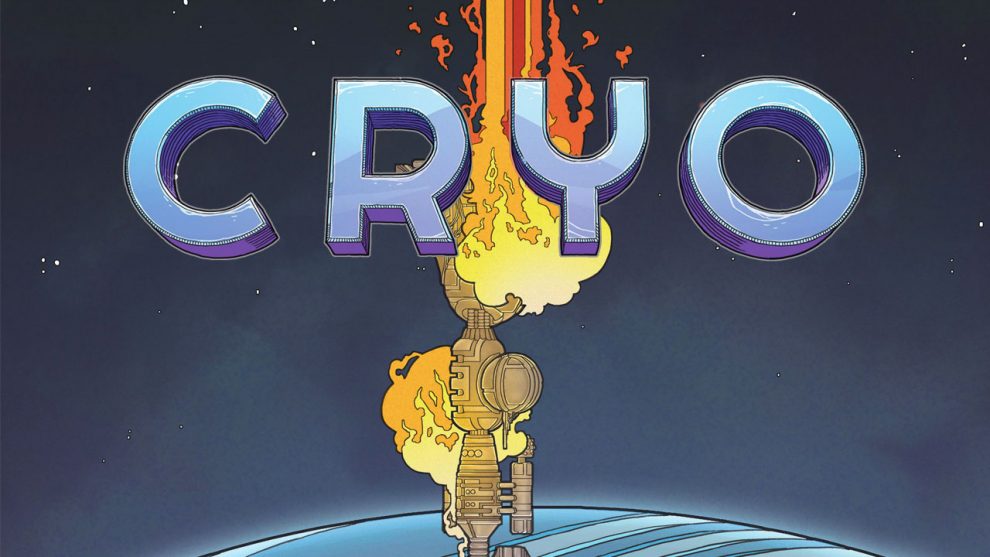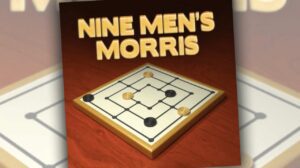Disclosure: Meeple Mountain received a free copy of this product in exchange for an honest, unbiased review. This review is not intended to be an endorsement.
Justin said in his piece about tiebreakers, that Dwellings of Eldervale—designed by Luke Laurie and published by Breaking Games—was the most fun he had playing board games in 2020. When he heard that Luke Laurie was the designer of a new game called Cryo, he knew he had to own it.
Tom, on the other hand, was immediately drawn in by the artwork. The vibrant colors and almost trippy inter-connected sci-fi board made Cryo an easy choice to play and review.
In Cryo, a colony spaceship has been sabotaged by an unknown party onboard. The ship crash-lands on a frozen, uncharted planet where anyone still on the surface will freeze to death at sunset. Players are tasked with controlling drones to move crew pods from the crashed ship into geo-thermal caverns below the planet’s surface.
Over the course of 7-10 turns (rounds don’t really apply in Cryo, which we’ll get to), players will send their three drones to the game board to take actions, draw and play cards, and launch vehicles into the caverns to drop off crew pods in the most valuable locations underground. The winner will be determined by the one who scores the most points.

Set Up
Start by laying out the large board.
The artwork depicts the four remaining sections of your crashed spaceship, as well as the caves below the planet’s surface. Understanding the board is crucial to rescuing your crew members, so let’s take a closer look.
The Board Layout
First is Engineering. This pink area allows you to retrieve Crystals which, in turn, can be converted into the Energy needed to pilot your ships into the safety of the caves.
Second is the Organics Laboratory. Organics are essential for moving your Pods from a Stasis Chamber to your ship so they can be moved underground. As well, here you’ll find a Fabricator where you can convert up to three of any type of resource into three Nanites, the material needed to explore the underground caves.
The brown area below the Organics Laboratory is the former Research and Development area of the ship. You can convert your Tech into an equal number of multi-use cards. You’ll need these cards to act as ships to transport your Pods to the underground areas, for special powers, or for special end game scoring conditions.
The last section of your former ship is the Dispatch area. Here you’ll be able to take actions to assign Pods to Salvage (for end-of-turn bonuses), withdraw them from Salvage to get them safely underground, and spend Nanite to send probes deep underground to find a safe haven for one of your Pods.
Continuing the Setup
Next, separate the flattened hexagonal chits by color: pink, green, and gray.
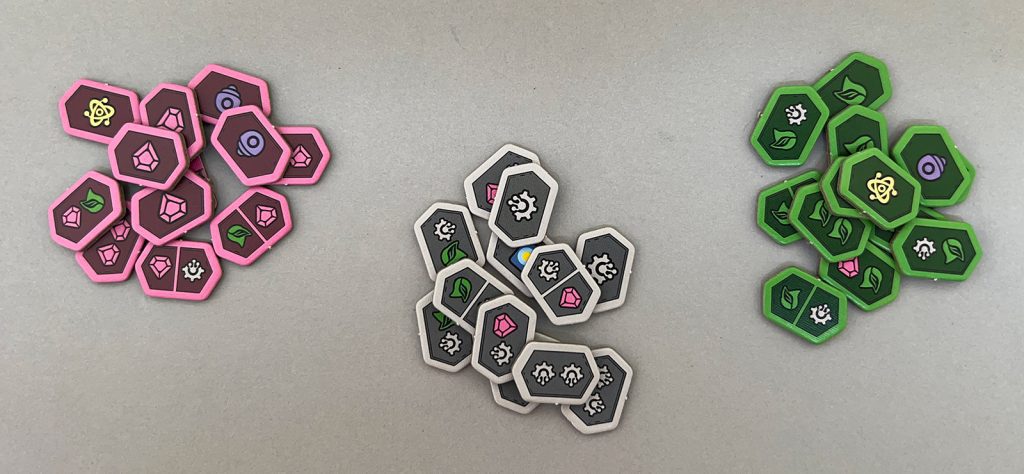
Randomly select four stacks of each color, with each stack equal to the number of players.
Arrange those stacks so one is face up and the others are face down. Then place them on the matching sections of the crashed ship on the matching shapes.
Take the sunburst-shaped Incident tokens and separate them by the icon on the back. Full suns are the Early phase, setting suns are the Late phase. Randomly place one Early phase token on the matching Incident space adjacent to each section of the ship.
Place the large Sunset tile in the appropriate space in the upper right corner of the board. Then place stacks of tokens equal to the number of players on the smaller spaces to the left as follows: three stacks of Early tokens starting at the far left; three stacks of Late phase with two stacks on the remaining spaces and one atop the larger Sunset token.
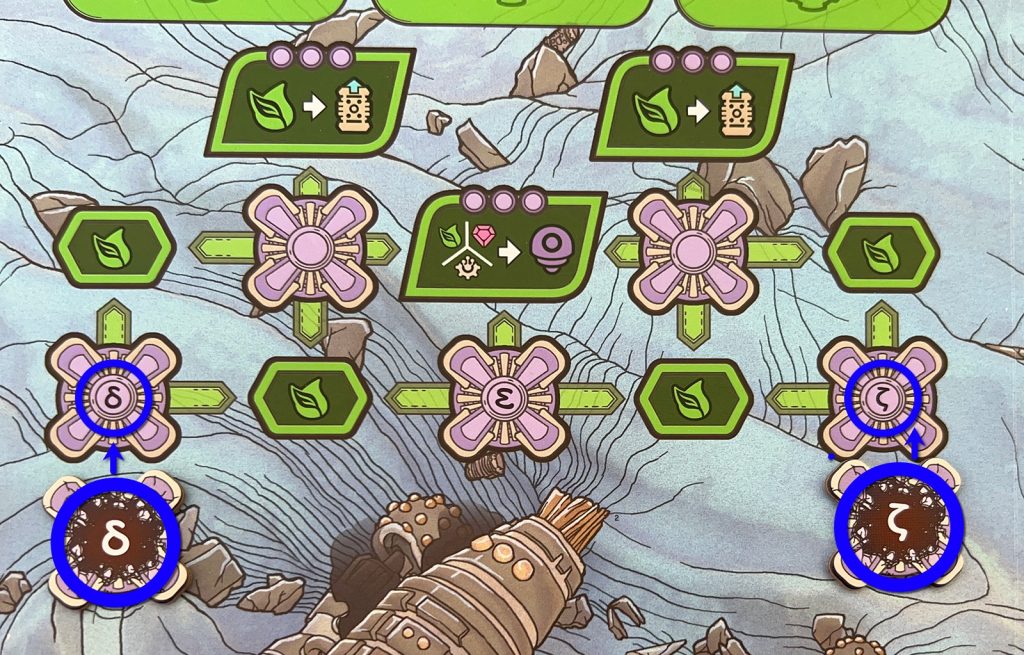
The crashed sections of the ship each have five docks. The three docks at the bottom of each dock have a unique symbol in the center. Randomly draw a set number of damage tokens based on the number of players and match their symbols to the docks on the board. Cover that dock with the damage token. These docks will not be accessible for the duration of the game.
The caves under the planet’s surface are at the bottom of the board. Randomly choose circular cavern tiles matching the size of the caverns that will be used in your game. Place them face down over the caves.

Then flip over the two cavern tiles to the far left of the underground area.
The Energy icon shows how much Energy you’ll need to expend to send a ship into each successive cavern. The icon to the left (if there is one) shows the Settlement cost in tokens while the icons to the right show the end game points the player with the majority of Pods (and second place, if applicable) will earn from Settling that cavern.
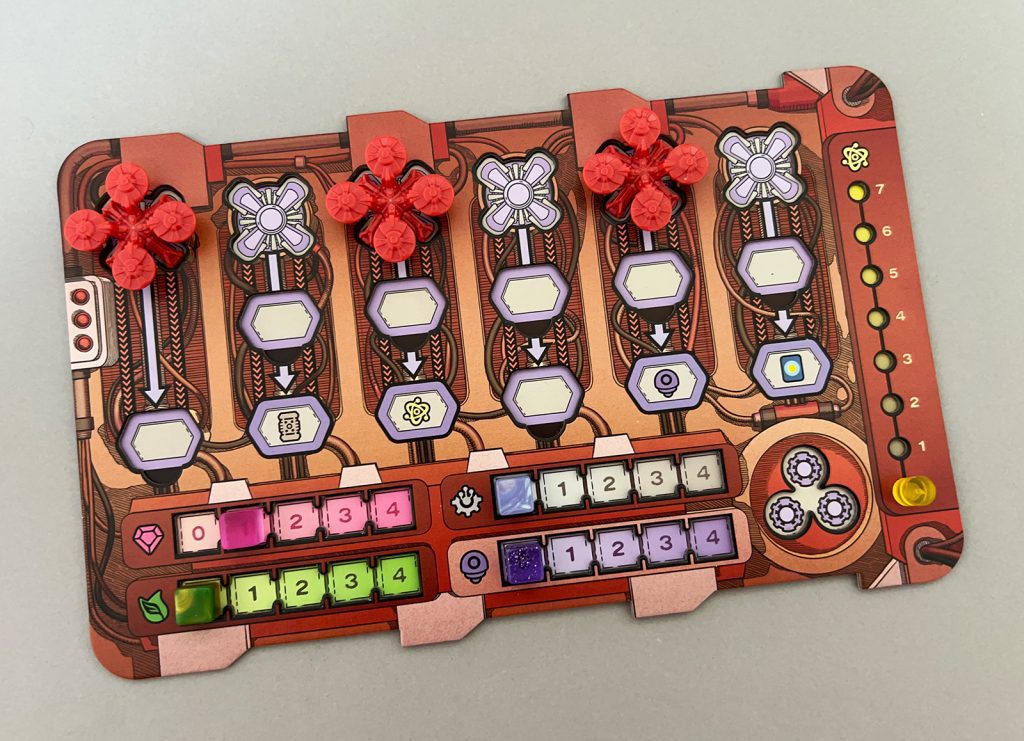
Each player should then select a color and take the accompanying player board. They should also take the cubes to track their Crystals, Organics, Tech, and Nanite. Place the yellow peg in the “1” slot of the Energy track along the right edge.
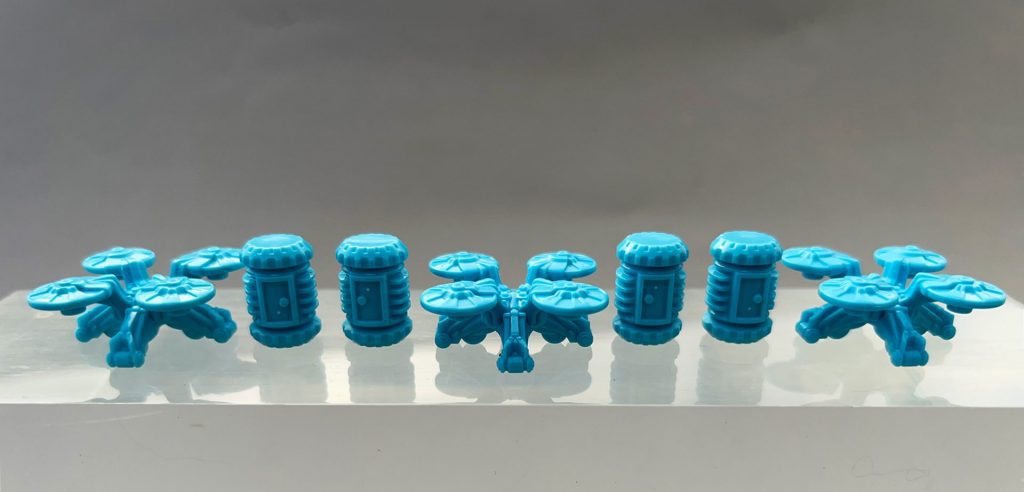
Then take all the Robots and Pods of the same color. Place the Robots into any of the cut-out slots along the top of the player mat.
Place three Pods in each of the three Stasis chambers at the top of each section of the ship.
Deal each player five cards. Players will choose three to keep and discard the other two.
And now you’re ready to play.
How to Play
On a turn, players will take one of their robotic drones and move it to an available dock on the board. From there, they follow the arrows from the dock and take any action available to them.
Cryo is, in part, an engine-building game. Early on, you’ll likely visit docks to take a resource tile, which give you a choice: you can trash the tile immediately to gain materials, energy or card actions, OR you could use the tile to upgrade your platform. In this way—a little like how the recall action works in Dwellings of Eldervale, not surprisingly—you’ll be able to generate additional actions to improve the efficiency of your operation on the planet.
Take another look at your player mat. Along the top there are six different spots for your robots to return to. Each one has the potential for helping you gain the resources you’ll need throughout the game.
After all, once you’ve deployed all of your robots you’ll need to recall them. You might as well get something for each of those return trips.
Take a look at how Red has developed his player board.

If Red returns a robot to the far left landing spot, Red will gain two Organics. If Red lands in the next spot, they can trade either an Organic or a Crystal for a Pod. The third landing spot will allow them to convert an Organic into an Energy. The far right landing spot will allow an Organic to be traded for a card.
Before we go any further, we need to talk about the cards.
Cards in Cryo have not two, not three, but four different possible uses.
To play a card you can choose to:
- Scrap: you can burn any card in your hand once per turn to receive materials or energy listed in the Scrap section of the card
- Upgrade: you can play a card into one of the three slots at the top of your platform to get an ongoing benefit in place for the rest of the game
- Mission: you can play a card facedown to the left of your platform; at the end of the game, you’ll get extra points based on the mission’s requirements
- Vehicle: you can slot the card on the bottom of your platform to use it once to transport 2-4 crew pods into caverns below the planet’s surface
The final, and most important, action you’ll take during your deploy steps is to launch cards you’ve turned into vehicles into the cavern. Why is this so important? In my experience, about 75% of my scoring has come from scoring the pods in caverns and any area majorities that come from owning a particular cavern, plus missions I have collected tied to pods in those same caverns.
All caverns list a number of points the player will receive if they have the most crew pods in a cavern. Plus, 3 of the 8 mission types available in the game relate to crew pods in caverns; even the rulebook highlights multiple times that your plans should be intrinsically tied to moving crew pods into caverns, so it’s easy to stay focused.
Although a Starting Player is randomly chosen, there is no real turn order in Cryo. It’s true that you have three drones to send out to the remains of the ship and after sending those three drones out you’ll need to recall them all. However, you can recall your drones before placing your third one on the board.
Why would you want to do this? Well, there may be instances when your opponents seem to be hogging the docks you want to land on. Taking your drones back before placing all three can disrupt the drone placement order to your advantage.
The other reason goes back to those Incident tokens. You know, the ones with the different phases of the sun.
After recalling your robotic drones, you also claim one of these Incident tokens. Some provide you with a helpful resource. Others allow you to blow up an attached Stasis Chamber and, thus, destroy all the Pods in it.
It’s important to note that while mission cards and some other factors will play into the scoring, the vast majority of player points will come from getting pods underground and having a majority in each portion of the cavern. Getting your Pods there first, is important, as is eliminating the competition.
Thoughts
Justin
Nothing screams “games for the modern gamer” quite like the tight gameplay loop of Cryo.
The backstory is just detailed enough to set the table. The teach is simple, and the manual clearly points out what Tom discusses about scoring: your goal is to get pods underground. The majority of your scoring comes from pods and the area majority mechanic. Even a 4-player game with all new players can be finished in 90 minutes, with successive plays taking much less.
Tom
I agree. After my group’s first game, subsequent games were all over in just over an hour. The backstory feeds into the gameplay so well that your actions just make sense.
Justin
The design, then, does not have many layers: everyone gets their respective engines going, then everyone moves their pods underground in waves. I have never seen a player win by focusing on something other than getting as many of their pods to the cavern as possible. Once you’ve played Cryo six times (as I have), you have seen everything the game has to offer.
And that’s fine by me.
Tom
Good point. My one complaint about Cryo is there is a lot of sameness to each play. You’re each going to be competing to get your engine built in common ways before shuttling your pods into those caves.
What saves Cryo for me are two things: first, everyone is going to be building their engines a little differently and, by and large, they can all be made to work; second is the idea that if you feel you’re getting shut down in a resource due to turn order, you bring your ships back in early, giving you a slight boost in turn order. It’s a clever mechanic that works well.
Justin
Ahh, great point: “[the engines] can all be made to work.” I agree here; I haven’t won every one of my plays, but I might have a slight advantage over a less experienced player if only because I’ve seen the variety of ways players have made their respective engines work.
The most underutilized mechanic in the games I’ve played is exactly what you call out: that you could use the Recall action “early.” This provides a couple of advantages, especially if you are short on resources: it lets you get income from your salvage; you might grab a single resource from an incident token, and you are able to get more things from your platform/player board.
Cryo is interactive, with an occasional rusty shiv to the gut of another opponent who has a pod in a section of the ship that is about to be sabotaged. The quality of the components in the retail version of the game are excellent, save for the player boards warping a little faster than I would like. (It’s like the game knew it had a limited shelf life.)
Tom
I’m willing to forgive the warping since the player boards are indented with spaces for each of the components to rest in and not on. (I’m still looking at you, Terraforming Mars.)
Justin
In my experience—and maybe this is just mine alone—board games get only a couple of chances to impress before players move on to the next hot game. Cryo grabs you quickly but never overstays its welcome. Right around the time you notice that your neighbor has pods in a couple of the highest-scoring caverns, the endgame is likely underway. 20 minutes later, the game is probably going to be over.
Tom
Cryo combined a lot of familiar mechanics in a new and different package. Combine that with the storyline and the playing time and it’s no surprise it’s such a good game.
What did you think of the cards having four separate uses? We really liked them.
Justin
I love multi-use cards. I just wish there was a bigger variety. More fuel for the “game for the modern gamer” fire? Cryo needed more than 8 types of cards. Maybe the plan by Z-Man all along was to build future expansion content, another leg of the modern tabletop business; in this regard, Cryo features just enough for basic, but never enough for a game that would survive 10+ plays without a content boost.
Tom
I was frustrated by the limited number of cards as well. It was the one part of the game’s design that felt lazy to me.
I’d be willing to try out an expansion for Cryo, but I’m not sure the game would get to the table enough to warrant the cost of an expansion. As it is, I know I can bring it to my weekly game nights every few months and it will be welcomed like an old friend. That says a lot, I think.
Final thoughts?
Justin
Cryo is an excellent medium-weight game and I’m glad to own it. Like my love affair with Dwellings of Eldervale, Cryo does efficient work and stays in its lane long enough to make a lasting impression.
Tom
Well stated, my friend! I wholeheartedly agree.


